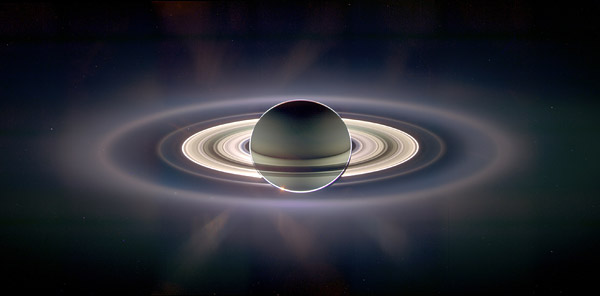
Enhanced image of Saturn eclipsing the Sun taken in 2006 by the robotic Cassini spacecraft. Courtesy NASA/JPL.
There’s something special about seeing Saturn in a telescope. Sure, viewing any of the planets is pretty great – the telescope reveals an object that to our eyes appears to be a star is actually a disc, a whole ‘nother world. It’s enough to get any observer’s heart pumping.
But then there’s Saturn – it’s not just a disc. Currently when viewed at very low powers the rings form much of the visual bulk of the planet, giving it an oval appearance with a hint of dark separation between the planet and its rings. What a surreal viewing experience to see this strange, wonderful object hanging in space.
With Saturn rising shortly after 7:00 PM and setting around 5:00 AM, now is a good time to view the planet, which is a showpiece in even small telescopes. For the best view, try to catch the planet as high in the sky as you can – currently it reaches maximum altitude around midnight. At my 40°N latitude the planet only gets up to ~30° so the atmosphere can make high power viewing difficult but still worthwhile. I was able to take advantage of a recent clear night to view Saturn with both a 60mm refractor and the Celestron FirstScope.
Saturn in the FirstScope
The Celestron FirstScope is not designed to be a lunar or planetary telescope – its short focal length makes it best suited for low power viewing of star fields and it does reasonably well on brighter Deep Sky Objects. Still, if you have one it is certainly worth taking a look at the Moon and planets.
In the FirstScope Saturn was clearly non-stellar at 12x in a 25mm Plossl. The rings were not distinct from the globe at this magnification but the entire body has an oblong appearance very different from the point-like stars.
The 4mm SR eyepiece allowed the rings to be seen but on this night the performance of the 2 element eyepiece was a let down not really capable of giving a sharp view. A 6.4mm Plossl was much clearer and didn’t give up much in the way of magnification (I suspect the 4mm SR is actually closer to 5-6mm). At 50x the image was small but the form of the rings and separation from the globe clearly seen – impressive for such a tiny, inexpensive scope.
60mm Refractor View
Next I brought out a 60mm refractor. While the FirstScope’s strength is low-power wide field views, the common long focus 60mm refractor tends to perform best on the Moon and brighter planets so Saturn is right up this scope’s alley.
At 43x the refractor gave small but well defined image that was clearly better than what the FirstScope could give at 50x. Increasing the power to 121x gave the image some real scale. Separations between the globe and rings took on a 3D appearance due to the visible shadowing, and the Cassini Division between the rings was visible as well as some subtle cloud bands on the planet’s surface.
Saturn in Larger Telescopes
With all of these features visible in a 60mm refactor, what does a larger telescope add to the view? While I didn’t bring out a larger scope for this session I can offer some comparisons from previous sessions with 5″ and 10″ telescopes.
As we know, a larger telescope will gather more light resulting in a brighter image at a given magnification so it makes sense that in both of the larger scopes there is more variation in color. Cloud banding is more easily seen and the globe takes on a peach hue compared to the golden yellow rings.
We also know that a larger aperture will resolve finer detail provided the seeing, or atmospheric stability, allows. As we might expect, the Cassini Division is more starkly defined in the larger scopes.
So while the additional detail can make the view more immediate, Saturn and its ring system is a beautiful sight in even the smallest telescope.
-Dave
Original content copyright 2015 by David Philips. All Rights Reserved. This post may contain links to affiliate sites; sales through affiliate links may benefit this site.